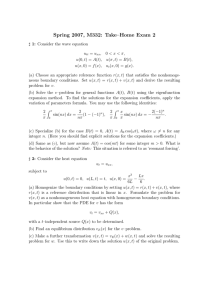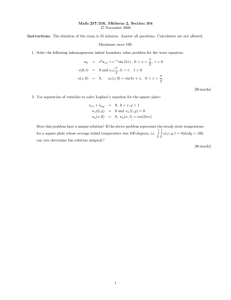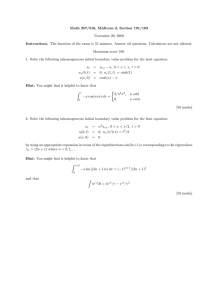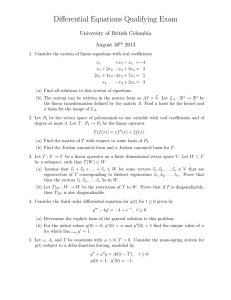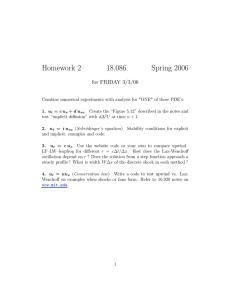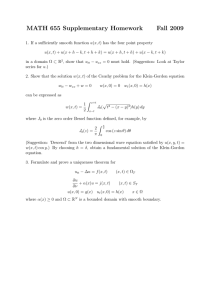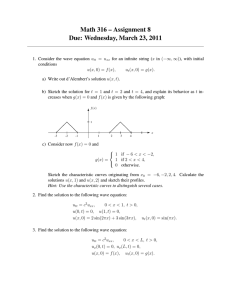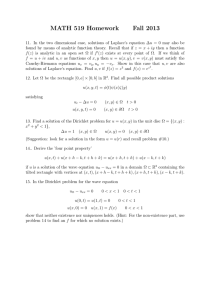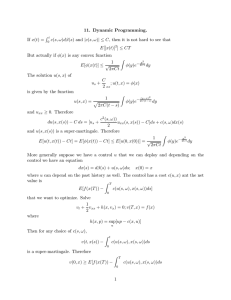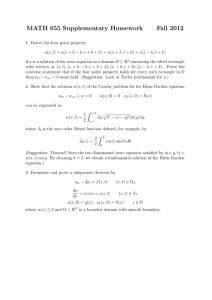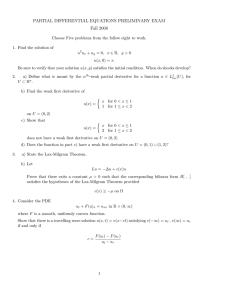WINTER 2011 PDE PRELIMINARY EXAM
advertisement
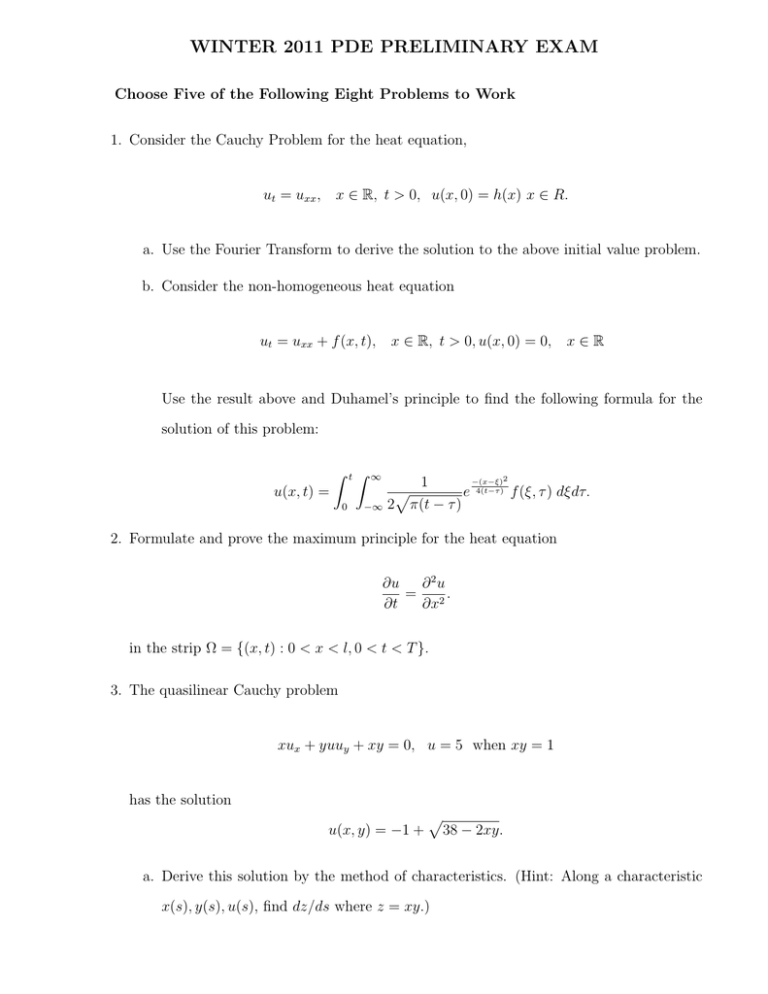
WINTER 2011 PDE PRELIMINARY EXAM
Choose Five of the Following Eight Problems to Work
1. Consider the Cauchy Problem for the heat equation,
x ∈ R, t > 0, u(x, 0) = h(x) x ∈ R.
ut = uxx ,
a. Use the Fourier Transform to derive the solution to the above initial value problem.
b. Consider the non-homogeneous heat equation
x ∈ R, t > 0, u(x, 0) = 0,
ut = uxx + f (x, t),
x∈R
Use the result above and Duhamel’s principle to find the following formula for the
solution of this problem:
Z tZ
∞
u(x, t) =
0
−∞
−(x−ξ)2
1
p
e 4(t−τ ) f (ξ, τ ) dξdτ.
2 π(t − τ )
2. Formulate and prove the maximum principle for the heat equation
∂2u
∂u
.
=
∂t
∂x2
in the strip Ω = {(x, t) : 0 < x < l, 0 < t < T }.
3. The quasilinear Cauchy problem
xux + yuuy + xy = 0, u = 5 when xy = 1
has the solution
u(x, y) = −1 +
p
38 − 2xy.
a. Derive this solution by the method of characteristics. (Hint: Along a characteristic
x(s), y(s), u(s), find dz/ds where z = xy.)
b. Verify the u(x, y) is a solution in the domain defined by xy < 19.
4. Consider the first order equation
ut + uux = 0, x ∈ R, t ≥ 0,
u(x, 0) = h(x), x ∈ R.
a. Define what it means to be a weak solution of the above problem.
b. For u0 > 0 and
h(x) =
u0
for x ≤ 0
u0 (1 − x) for 0 < x < 1,
0,
for x ≥ 1,
Show that a shock develops at a finite time and describe the global weak solution.
5. Let
x2 for x ≥ 0
r(x) =
0 for x ≤ 0.
Compute all distributional derivatives of r: D(r), D(2) (r), . . .
6. Let G be an open subset of Rn .
a. Let f ∈ L2 (G). Show how f defines a continuous linear functional on H 1 (G).
b. State the Lax-Milgram theorem.
c. Show that the Lax-Milgram theorem may be applied to the bi-linear mapping
B[u, v] =
n Z
X
i=1
G
Z
∂i u∂i vdx +
uvdx
G
and f as in part a) above.
d. Assume that G is a bounded open set with C ∞ boundary and let u be the LaxMilgram solution just determined. What partial differential equation (in the sense of
distributions) does u solve?
7. Let D ⊂ Rd be a bounded domain with smooth boundary ∂D. Assume that the complete,
orthonormal set of eigenfunctions {φn } for the negative Dirichlet Laplacian on D is known,
in other words,
−∆φn = λn φn , in D, n = 1, 2, 3, . . . ,
with φ = 0 on ∂D, and
R
D
φ2n dx = 1 and each λn > 0.
a. Given f ∈ L2 (D), find a closed-form series solution u(x, t) for the initial boundary
value problem for the wave equation
utt − ∆u = 0, for t > 0, x ∈ D,
u(x, t) = 0, x ∈ ∂D,
u(x, 0) = f x ∈ D.
ut (x, 0) = 0 x ∈ D.
b. Show that
1
E(t) =
2
Z
u2t + |∇u|2 dx
D
is constant.
8. Let
g(x) =
1 − |x| when
|x| ≤ 1;
0
|x| > 1
when
Sketch profiles of the solutions of two Cauchy problems (1), (2) at time t = 1.a
utt = uxx ,
u|t=0 = g(x),
ut = uxx ,
ut |t=0 = 0, x ∈ R.
u|t=0 = g(x), x ∈ R
(1)
(2)

